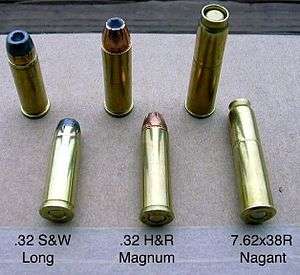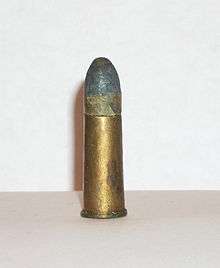Nagant M1895
| Nagant M1895 revolver | |
|---|---|
|
A Nagant M1895 produced in 1941 by the Tula Arsenal with its 7.62×38mmR ammunition | |
| Type | Revolver |
| Place of origin |
Belgium Russian Empire Soviet Union |
| Service history | |
| In service | 1895–1950s (USSR) |
| Used by | See Users |
| Wars |
Boxer Rebellion Russo-Japanese War World War I Russian Revolution of 1917 Russian Civil War Spanish Civil War Winter War World War II Chinese Civil War Hukbalahap Rebellion Korean War Vietnam War |
| Production history | |
| Designer | Emile & Léon Nagant |
| Designed | 1886 |
| Manufacturer | Nagant, Soviet Arsenals (Tula & Izhevsk), Państwowa Fabryka Karabinów[1] |
| Produced | 1895-1945 (1895-1898 Nagant, 1899-1945 Tula, 1930 Warsaw, 1943-1945 Izhevsk) |
| Number built | ~2,000,000 |
| Variants | Single-action NCO version, .22 caliber sporting model |
| Specifications | |
| Weight | 1.8 lb (0.8 kg), unloaded |
| Length | 10.5 in (235 mm) |
| Barrel length | 4.5 in (114 mm) |
|
| |
| Cartridge | 7.62×38mmR 7.62mm Nagant |
| Caliber | 7.62mm |
| Action | Double action, Single-action |
| Rate of fire | 14-21 rounds/min |
| Muzzle velocity | 891 ft/s (272 m/s) |
| Effective firing range | 50 yds (46 m)[2] |
| Feed system | 7-round cylinder |
| Sights | Fixed front post and rear notch |
The Nagant M1895 Revolver is a seven-shot, gas-seal revolver designed and produced by Belgian industrialist Léon Nagant for the Russian Empire.
The Nagant M1895 was chambered for a proprietary cartridge, 7.62×38mmR, and featured an unusual "gas-seal" system, in which the cylinder moved forward when the gun was cocked, to close the gap between the cylinder and the barrel, providing a boost to the muzzle velocity of the fired projectile and allowing the weapon to be suppressed (an unusual ability for a revolver).[3]
Russian M1895
Léon Nagant and his brother Émile were well known in the Russian Tsar's court and military administration because of the part they had played in the design of the Russian service rifle, the Mosin–Nagant Model 1891. The Nagant M1895 was adopted as the standard issue side arm for the Imperial Russian Army and police officers, where it replaced earlier Smith & Wesson models.[4]
Production began in Liège, Belgium; however Russia purchased the manufacturing rights in 1898, and moved production to the Tula Arsenal in Russia, and was soon producing 20,000 examples per year.[4]
Until 1918 it was produced in two versions: a double-action version for officers, and a cheaper single-action version for the ranks.[5] It continued to be used after the Russian Revolution by the Red Army and Soviet security forces. The distinctive shape and name helped it achieve cult status in Russia and in the early 1930s the presentation of a Nagant M1895 revolver with an embossed Red Star was one of the greatest honours that could be bestowed on a Party Member. The common Russian name for the revolver, наган (nagan) became synonymous with the concept of the revolver in general and was applied to such weapons regardless of actual make or model.
As early 1933 the M1895 had started to be replaced by the Tokarev semi-automatic pistol but was never fully replaced until the Makarov pistol in 1952. It was still produced and used in great numbers during World War II and remained in use with the Russian Railways, postal service, and some remote police forces[6] for many years. In the Russian Federation, it was only retired from use with postal security service in 2003, and from bailiff security service (Федеральная служба судебных приставов) in 2009.[7]
Technical characteristics
Non-gas seal revolvers have a small gap (known as a flash gap) between the cylinder and the barrel; the small gap between the cylinder and barrel is necessary to allow the revolver's cylinder to revolve, presenting a new, loaded chamber for firing. This necessitates that the bullet jump the gap when fired, which may have an adverse effect on accuracy, especially if the barrel and chamber are misaligned, and also presents a path for the escape of high-pressure and high-temperature gases from behind the bullet. Expensive revolvers such as Korth and Manurhin are hand-fitted, keeping the gap to a minimum. Mass-produced revolvers such as Smith & Wesson may have a gap as large as 0.25 mm.
The M1895 by contrast, has a mechanism which, as the hammer is cocked, first turns the cylinder and then moves it forward, closing the gap between the cylinder and the barrel. The cartridge, also unique, plays an important part in sealing the gun to the escape of propellant gases. The bullet is deeply seated, entirely within the cartridge case, and the case is slightly reduced in diameter at its mouth. The barrel features a short conical section at its rear; this accepts the mouth of the cartridge, completing the gas seal. By sealing the gap, the velocity of the bullet is increased by 15 to 45 m/s (50 to 150 ft/s.) This feature also eliminates the possibility of injury through the dangerous expansion of gases from the cylinder behind the barrel, which are easily capable of severing a finger if the user holds the gun incorrectly (with a finger positioned in front of the cylinder during fire) - a noted safety-issue in conventional revolvers.[8]

The disadvantage of this design is that Nagant revolvers were laborious and time-consuming to reload, with the need to manually eject each of the used cartridges, and reload one cartridge at a time through a loading gate.
The Nagant M1895 was made in both single-action and double-action models before and during World War I; they are known colloquially as the “Private's model” and the “Officer’s model”, respectively. Production of the single-action model seems to have stopped after 1918, with some exceptions, including examples made for target competition. Most single-action revolvers were later converted to double-action, making original single-action revolvers rather rare.
Whether fired in single action or double action, the Nagant M1895 has a markedly heavy trigger pull.
History and usage
The M1895 revolver was used extensively by the Russian Imperial Army and later by the Soviet Union after the Russian Revolution. In Russian service, it was known for its extreme sturdiness and ability to withstand abuse. As one former Imperial Russian officer stated, "if anything went wrong with the M1895, you could fix it with a hammer".
It was widely employed by the Bolshevik secret police, the Cheka, as well as its Soviet successor agencies, the OGPU and NKVD. In the police role, it was frequently seen with a cut-down barrel to aid in concealment by plainclothes agents. Despite the advent of the more modern Soviet TT pistol, the M1895 remained in production and use throughout World War II.
The Nagant's sealed firing system meant that the Nagant revolver, unlike most other revolvers, could make effective use of a sound suppressor, and suppressors were sometimes fitted to it.[9]
Suppressed M1895 Nagant revolvers, modified in clandestine workshops, also turned up in the hands of Viet Cong guerrillas during the Vietnam War as assassination weapons. There is an example of a suppressed Nagant M1895 in the CIA Museum in Langley, Virginia, USA.
Variants
Military
- Nagant “Private's model” («солдатский» наган) - a single-action version for non-commissioned officers and soldiers
- Nagant “Officer’s model” («офицерский» наган) - a double-action version for officers
- suppressed Nagant[10] with sound suppressor known as the "BRAMIT device" (BRAtya MITiny - "Mitin Brothers") - produced since 1929 for Soviet reconnaissance and scout troops
- Ng wz. 30 (Nagant wz. 30)
Civil
- KR-22 «Sokol» (КР-22 «Сокол») - .22 LR[11]
Cartridges
Russian
7.62mm Nagant is also known as 7.62×38mmR (Rimmed) or "Cartridge, Type R". The projectile is seated below the mouth of the cartridge, with the cartridge crimp sitting just above the bullet. When fired, the crimp expands into the forcing cone, completing the gas seal and ostensibly increasing muzzle velocity by approximately 75 ft/s.
The 7.62 mm caliber was chosen, in part, to simplify the tooling used in barrel-making and manufacture of projectiles because the Russian service rifle of the time, the Mosin–Nagant M91, featured an identical bore diameter, being chambered for the 7.62×54mmR rifle cartridge.
The revolver can be fired using the .32 S&W, .32 S&W Long and .32 H&R Magnum cartridges, but this practice is not generally advised. .327 Federal Magnums should never be fired in this revolver. The Nagant revolver was not designed to fire these rounds, which have different dimensions, so the shooter should be aware of the risks before attempting to use them in the revolver. Aftermarket cylinders for .32 can be installed, allowing them to safely fire .32 H&R or .32 ACP.

Proper fitting ammunition can be reloaded from .32-20 Winchester brass by using the Lee Nagant die set. This allows the reloaders to work up a load that fits their needs and is specific for the Nagant. While this eliminates the bulged/split/stuck cases experienced when using .32 S&W and .32 H&R, the gas seal that made the Nagant famous will still not fully function, due to the .32-20 not being long enough to protrude past the cylinder like the original Nagant ammo.
Swedish / Norwegian

Other Nagant revolver designs were also adopted by police and military services of Sweden (7.5mm M1887), Norway (M1893), Poland, and Greece (Περίστροφον M1895).
The Swedish and Norwegian Nagants used a different cartridge, the 7.5 mm Nagant. This ammo is interchangeable with the 7.5mm 1882 Ordnance (aka Swiss 7.5mm revolver).[12][13]
Users
-
 Albania
Albania -
 East Germany[14]
East Germany[14] -
 Syria:by the Syrian army and special units and police
Syria:by the Syrian army and special units and police .svg.png) Belgium[15]
Belgium[15] Finland - Used captured arms
Finland - Used captured arms -
 Kazakhstan - at least up to 1996 were used by security guards[16]
Kazakhstan - at least up to 1996 were used by security guards[16] -
.svg.png) Nazi Germany - Like many other foreign weapons, captured Polish Nagant revolvers were used under designation Revolver 612(p), captured Greek Nagant revolvers were used under designation Revolver 612(g), captured Soviet Nagant revolvers were used under designation Revolver 612(r). Members of Polnische Polizei im Generalgouvernement and Hilfspolizei were armed with these revolvers
Nazi Germany - Like many other foreign weapons, captured Polish Nagant revolvers were used under designation Revolver 612(p), captured Greek Nagant revolvers were used under designation Revolver 612(g), captured Soviet Nagant revolvers were used under designation Revolver 612(r). Members of Polnische Polizei im Generalgouvernement and Hilfspolizei were armed with these revolvers  Norway
Norway Poland[1][6]
Poland[1][6] Russian Empire - since 13 May 1895[17]
Russian Empire - since 13 May 1895[17]-
 Russia - in 1998 were still used by some law enforcement units;[18] until 2003 were used by postal service security guards;[19] at least up to 2006 were used by security guards[20][21]
Russia - in 1998 were still used by some law enforcement units;[18] until 2003 were used by postal service security guards;[19] at least up to 2006 were used by security guards[20][21]  Soviet Union[6]
Soviet Union[6].svg.png) Second Spanish Republic[2][22]
Second Spanish Republic[2][22] Sweden[6]
Sweden[6] Kingdom of Yugoslavia[1]
Kingdom of Yugoslavia[1].svg.png) Kingdom of Greece
Kingdom of Greece-
 Ukraine - at least up to summer 2014 were used by railway security guards[23]
Ukraine - at least up to summer 2014 were used by railway security guards[23]  Philippines- few quantities were exported to the Philippines during the Philippine Revolution and the Philippine-American War. Known to be the sidearm of revolutionary General Antonio Luna
Philippines- few quantities were exported to the Philippines during the Philippine Revolution and the Philippine-American War. Known to be the sidearm of revolutionary General Antonio Luna
Others
See also
Notes
- 1 2 3 Tadeusz Kozieł (2007). "Przemysł zbrojeniowy w Polsce w latach 1918-1939" [Arms industry in Poland between 1918 and 1939]. konflikty.pl (in Polish). Retrieved 2013-08-08.
- 1 2 "Dossier Nagant Revolver". Chuckhawks.com. Retrieved 2010-07-20.
- ↑ Nagant Suppressed
- 1 2 Kowner, Historical Dictionary of the Russo-Japanese War, p. 248.
- ↑ Виталий Крючин. Арсенал: НАГАН: история жизни с продолжением // журнал «Братишка», май 2008 года
- 1 2 3 4 "Modern Firearms - Handguns - Nagant 1895". World.guns.ru. Retrieved 2010-07-20.
- ↑ Постановление Правительства РФ № 248 от 24.03.2000 «Об обеспечении служебным оружием, патронами к оружию и специальными средствами должностных лиц организаций федеральной почтовой связи»
- ↑ https://www.youtube.com/watch?v=nucg5VAff4c
- ↑ "Silenced 7.62 mm Nagant Revolver". Guns.connect.fi. 2000-09-18. Retrieved 2010-07-20.
- ↑ Jeff Kinard (2004). Pistols: An Illustrated History of Their Impact. ABC-CLIO. p. 161. ISBN 1-85109-470-9.
- ↑ Е. Александров. Под малый калибр. // «Калашников. Оружие, боеприпасы, снаряжение», № 8, 2010. стр.48-49
- ↑ http://www.vsms.org/Forum/Seite_23/23_7.5mm_CH_Ordonnanz.pdf
- ↑ Frank C. Barnes (2012). Cartridges of the World: A Complete Illustrated Reference for More Than 1,500 Cartridges. Gun Digest Books. p. 335. ISBN 978-1-4402-3059-2.
- ↑ "M1895 Nagant Revolver". 7.62x54r.net. Retrieved 2016-04-23.
- ↑ "M1895 Nagant Revolver". Retrieved 2012-09-11.
- ↑ Постановление Правительства Республики Казахстан № 1060 от 28 августа 1996 года "О внесении изменений и дополнений в некоторые решения Правительства Республики Казахстан"
- ↑ 13 мая 1895 года // журнал "Мастер-ружьё", № 5 (122), май 2007. стр.92
- ↑ Постановление Правительства РФ № 1584 от 30 декабря 1998 года "Об утверждении перечня боевого ручного стрелкового и иного оружия, боеприпасов и патронов к нему, а также специальных средств, состоящих на вооружении службы судебных приставов Министерства юстиции Российской Федерации"
- ↑ Постановление Правительства Российской Федерации № 248 от 24 марта 2000 года «Об обеспечении служебным оружием, патронами к оружию и специальными средствами должностных лиц организаций федеральной почтовой связи»
- ↑ Приложение № 2 к Приказу Министерства внутренних дел Российской Федерации № 611 от 4 августа 2006 года «Об утверждении перечней специальных средств, видов, типов и моделей огнестрельного и газового оружия, патронов и боеприпасов к нему, норм обеспечения ими работников военизированных и сторожевых подразделений ФГУП „Охрана“ МВД России»
- ↑ «Организации и их территориальные подразделения могут использовать до вывода из эксплуатации по техническому состоянию… 7,62 мм револьвер системы "наган"… иное боевое оружие, ранее приобретенное в установленном порядке и не включенное в настоящий перечень.»
Постановление Правительства Российской Федерации № 460 от 22 апреля 1997 г. «О мерах по обеспечению юридических лиц с особыми уставными задачами боевым ручным стрелковым оружием» (в ред. от 29 мая 2006 г.) - ↑ Archived May 9, 2008, at the Wayback Machine.
- ↑ "В Донецке вооруженные люди в управлении военизированной охраны Управления Донецкой железной дороги завладели... 4 пистолетами ТТ и 5 револьверами «Наган»"
В Донецке боевики завладели оружием управления охраны железной дороги // УНИАН от 28 июня 2014
References
- Wilson, Royce: "The Nagant M1895 Revolver". Australian & New Zealand Handgun, Issue 4 (January 2006).
- Kowner, Rotem (2006). Historical Dictionary of the Russo-Japanese War. ISBN 0-8108-4927-5: The Scarecrow Press.
- Gerard, Henrotin: "The Nagant revolvers". HLebooks.com, Ebook (2001).
- Gerard, Henrotin: "Nagant revolver Model 1878 explained". HLebooks.com, Ebook (2014).
External links
| Wikimedia Commons has media related to Nagant M1895. |
- Modern Firearms: Nagant model of 1895 (Belgium - Russia)
- Exploded Parts Diagram of M1895 Nagant Revolver
- NAGANT info
- Nagant 1895 Pictorial
- https://www.youtube.com/watch?v=Dh1mojMaEtM
- http://www.russianrevolvers.com/nagant_belg.html
- Nagant 1895 internal mechanism (modern technical drawing)
